The stuff that a horse wears is called tack. Most tack is used either to control the horse, or to keep the rider on. What style of riding you do, what breed of horse you ride, your skill, the horse’s level of training, and your budget, determines what you put on your horse.
This is Tonka’s bridle. I keep it simple on purpose. (Although I do like that bit of patent leather on the noseband and the onyx and pearls on his browband. Simple can also be handsome!)
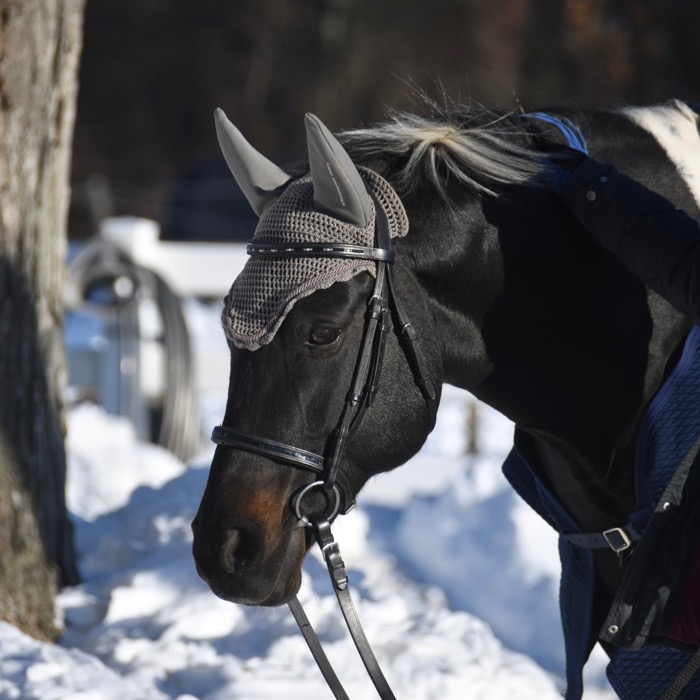
Tonka has squat Paint Horse ears. They’re bigger at the base than many other breeds. I tried several bridles before I found one that had a crown piece that allowed enough room for Tonka to comfortably swivel his ears.
Basically, a bridle is there to keep the bit in the horse’s mouth. Reins attach to the bit so that you can steer and stop the horse. Although there’s a full set of teeth in the horse’s mouth, there’s a gap between the front ones and the molars, right at the corners of the lips. That’s where the bit goes. A properly fit bit should rest neutrally on those bars, over the tongue. Some people believe that all bits are painful for the horse. I don’t. But many bits are. And even the mildest bit, in harsh hands, can hurt.
A horse in pain will try to avoid the bit by opening their mouth, or going with their head in the air, or curling their neck to avoid pressure. To prevent that, there are bridles with nose bands that crank the horse’s jaw shut, or, there are straps that go over the nose and close the mouth. Sometimes both are used on one bridle.
Tonka’s noseband does none of those things. It has three purposes: 1) it keeps the bridle plumb on his head 2) it’s traditional to have a noseband on a dressage bridle 3) it’s pretty.
If Tonka opens his mouth, or does any of those other things that tells me that the bit hurts, I reevaluate how I’m riding, what I’m asking him to do, and whether the gear fits. I could use a bitless bridle. Tonka would turn and stop in it. But, I appreciate the finesse of communication I can get from a bit. For example, if I close my pinky on the left rein and slightly change the weight in my elbow, Tonka responds with a softening through his head and neck and look slightly left. Add left leg pressure, while at the same time stepping down in my right stirrup, and Tonka will balance with cadence through a corner. I love this tactile conversation.
(In this photo my right hand is curled. This is wrong. It’s a bad habit I’m trying to break. But at least it doesn’t pull on Tonka’s mouth.)
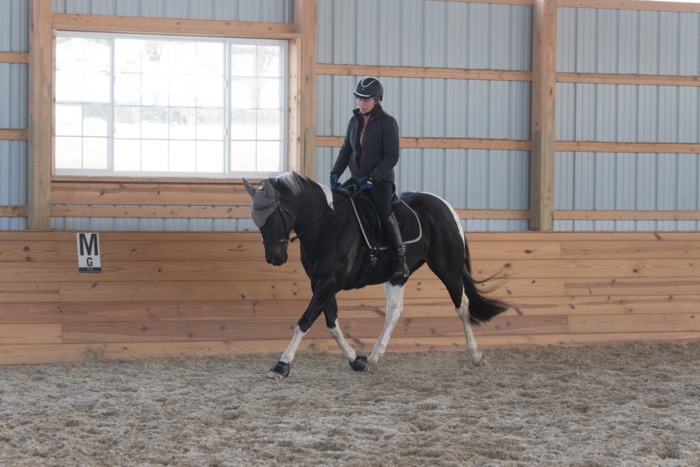
In dressage, riders have to have very still hands, and then use them in subtle and nuanced ways, to be able to communicate with the horse via the bit in the way that it is designed for. If all you need to do is stop and turn, a bit might not be necessary. I wish that I could go back and reteach all of those beginner riders that I used to work with. I’d use bitless bridles until their bodies and hands were steady.
As with everything, the arguments for or against bits are not black and white. I’ve seen bitless bridles that put pressure on a horse’s poll, others that act severely on facial nerves, others that create pain on the nose. Some horses, because of past history, ignore the pull of a gentle bitless bridle, and to keep the rider safe, one has to use a bit. (But that’s another story. So many horses need retraining to pay attention to and trust their owners. In the meanwhile, one has to find what is effective, and with as much comfort as possible, for both horse and rider.) Each case is unique. One of my clients has an elderly horse who is having difficulty swallowing when a bit is in his mouth. A bitless bridle that is basically a halter with reins, (something like this) is allowing him to still go out on leisurely walks with his owner.
Meanwhile, Tonka and I are getting along fine with a gentle bit and my on-going efforts to have kind, communicative hands.
When I ride, I reward Tonka with praise, rest, forward movement and cookies. (Do you see the little brown snack in his bottom lip?)
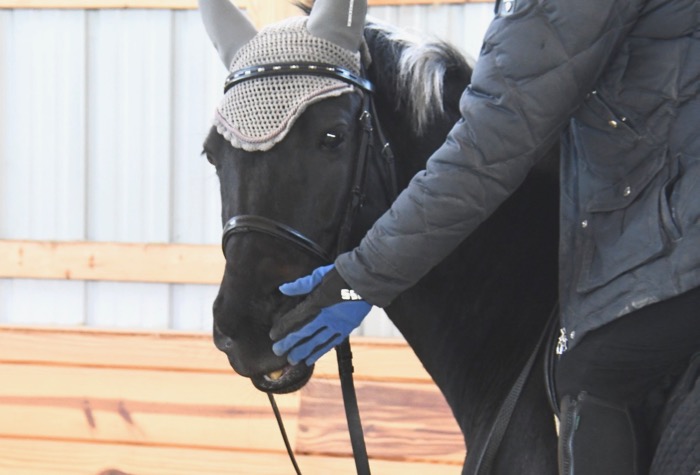
By the end of the ride, there are crumbs and saliva in the corner of his mouth. It’s itchy. When I untack him, he gets a rub.
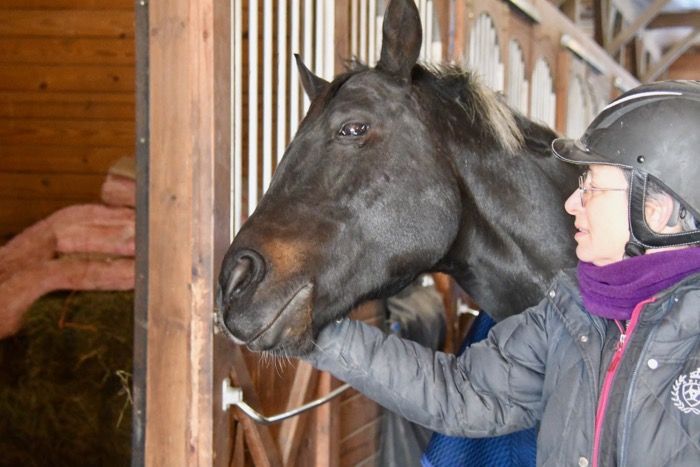
Tonka loves having his lips and gums massaged.
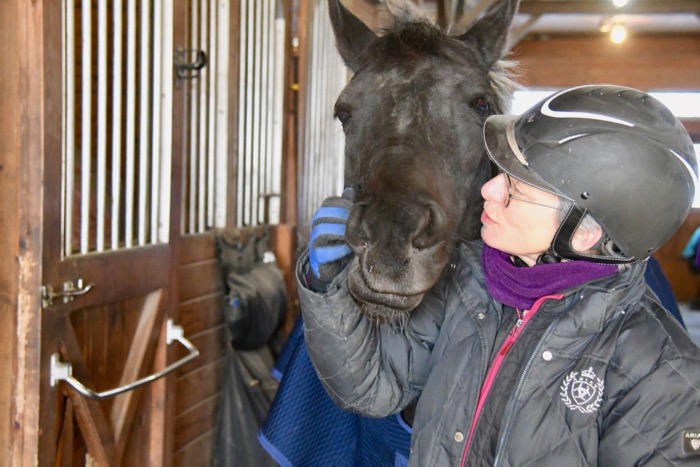
He asks for this. Tonka is not self-conscious about looking silly.
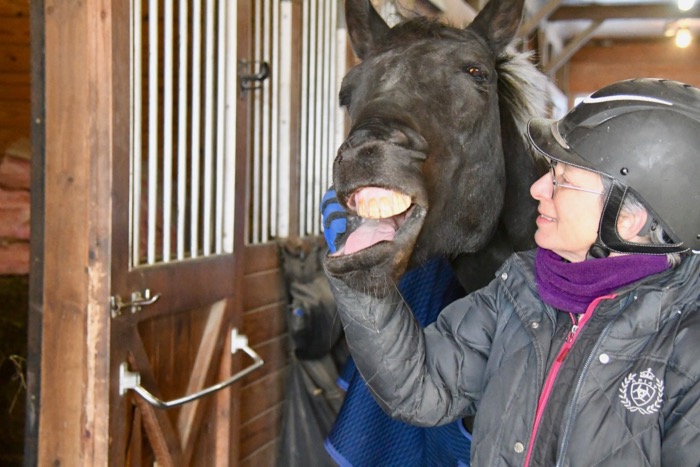
Nor is he shy about showing affection.

Please note: this discussion of bit or bitless can be a flashpoint. I welcome comments. However, I will delete any comments that I feel aren’t kind. There are plenty of other forums to rant



I love that you’re talking about this! I understand your point about finesse, but have actually personally never experienced a horse that did not respond to equally light pressure in a bitless bridle as in a bit (in fact, my little mare was even quicker to respond to the tiniest cues in her scrawbrig, then the Transcend double, but she was always a bit special). Of course, as you say it all comes down to training in the end anyway. In my view, generally less damage can be done by a bitless bridle, since most riders do not have the light hands a bitted horse would hope for. With practice of those light hands and training for subtle cues, a dressage horse can go equally well bitless (it’s just a shame that it isn’t dressage legal yet).
I so enjoy doing lower level dressage and I enjoy teaching it to others. I believe that for most of us, change will come with small revelations and within our comfort zones. And that’s not a bad thing! On the other hand, if you’re able to ride in a sympathetic and effective way with your bitless bridle, then I think it should be allowed in competition. Glad you’ve had a special little mare on this journey.
As you noted, bitless bridles can definitely be just as harsh as bits, as can anything in the wrong hands. My daughter has become somewhat of a bit collector, so we have quite a few to choose from in our tack room. It’s nice to be able to go through and find out what your horse likes best. Right now, I’m using something called a simplicity bit with a 3 piece mouthpiece, chain in the middle. My curb chain is so loose it is basically there for looks. It is a very forgiving bit – there is a small gag which gives him time to respond before any contact occurs, and covers for my sometimes bad hands. My horse definitely tells me he loves it and works well in it. When I got my horse, the previous owners told me he had to work in a hackamore or bitless bridle, because he has a slice in his tongue (I’m sorry to say from some unscrupulous trainer in his long ago past). But he strongly told me that he did not like the nose pressure, so I started experimenting with bits, and we have now found what works best for both of us.
What our horses tell us when we listen to them!
I enjoyed this quite a bit. I have ridden my colt in a halter most of the time since I started him but recently switched to a snaffle. I wanted clearer communication so we could work on refinement. It’s been hard finding a bit he liked. I tried a merloth, he made it very clear he hated it. I used my plain old snaffle and he spent lots of time behind the bit with almost no contact. Now in a double jointed snaffle with a roller he is seeking contact. I love that I can feel him pushing into the bit, lightly of course. The only problem for me is that I hate when people change bits to gain more control and I have to keep telling myself that clearer communication is better control but not harsher control.
I know what you mean. If the bit is what you rely on for control, then I’d suggest you go back to the basics!
I love the idea of having new riders go bitless until they have better control of their upper bodies. I ride with a bit in the ring, and a rope halter on the trail (unless we’re galloping or jumping). I think it just depends what you’re doing.
If I had my druthers, I’d have my students on the lunge line until they could ride balanced with no stirrups and no reins!
A friend of mine actually gave me her bitless, I guess she chickened out of using it. However, she told me “the color was wrong for her horse”. I was amazed how I was able to take my horse trail riding with his bitless bridle. When we stopped to graze it made life a lot easier on him too. I love it and can’t see going back to a bit, but that’s just me.
Having met your horse, I can see that the bitless would have suited him.
I always used to ride bit less but, that was many many years ago and to be honest we hardly ever used a saddle either!! Love the pictures of Tonka having his rub, he is a wonderful affectionate softie, you have certainly found your ideal partner. Keeping fingers crossed that Tonka’s healing continues and he is soon back to his full form. :)Please tell Steve his pictures on Instagram were really good, your birds are such different colours to ours and your Robin is the size of our Blackbird.
I have let Steve know. We notice so much more about the birds that live near us, now that he photographs them. It makes you pay attention.
Tonka continues to improve daily, which is a great relief and pleasure to see.
I LOVE that you don’t use a “nutcracker” type snaffle and instead use the jointed bar type. And I love that you don’t use those infuriating ‘under bit’ nose bands. I hate them both. Right up there with hackamores. Ok, rant over. Thank you Terry, for riding humanely.
When I was a girl, I was taught that the simple snaffle was the kindest bit. It just shows that accepted wisdom should be questioned. I’m so glad I finally learned about other, more humane, bits.
Years ago, I found a very (VERY) soft, clearish color, silicone (?) straight bar snaffle bit. It was very bendable and I could bend it in half with two fingers. I used it on the mare I owned and rode the longest. I bought two when I first purchased it because I was told that it was so soft they could chew on it a bit and damage it as the bridle was being taken on and off, but never had to use the second one. I’ve seen hard rubber ones like it since, but I’ve never spotted the soft, clear, relatively thin one I used to use. Are you familiar with this? I loved it, and so did she. When working on tough things that were hard on her muscles or new to me, her “tell” that she was getting frustrated was to work her mouth in anxiety. It was unrelated to my hands, I believe. And when I moved from a metal bit to this one, her mouth was always relaxed. (Her “tell” then became tail swishing! And whenever she did it, I apologized and changed what I was doing.)
They still make them!
I like to use my bitless bridle in conjunction with my bareback pad for trail rides. I think it lets my horse know that we are just out having a relaxing, fun ride. A bitless bridle also allows for snacking should we come across some choice pasture. In the nicer weather, I’ll pack a lunch and a good book and off we’ll go. I’m so looking forward to doing that again! When we are having a lesson I do use a bridle with a bit.
A good horse, a book, a lunch, a long meander on the trails… sounds like perfection to me! I think you’re right – the horse will learn to distinguish when the outing is meant to be totally relaxing, and he’ll respond in kind.
A bit review could be great as an extension of this! It’s fascinating to see the array of not just bits, but things like bit-wrap, as well as alternative bits like the leather or biothane strap + curb bits.
There are a lot of complicated bits out there, and even the simpler bits have endless variations. Each horse’s mouth, training, and rider, is a unique study of one. But, as a general rule, select the mildest bit that suits your horse. Bitless can also be a valid option.
What I don’t do is rely on specialized bit to change my horse’s head carriage or way of going. That shouldn’t come from the mouth!